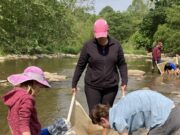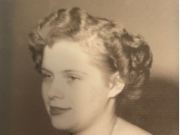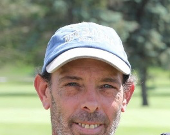Mantua – Last week, the entire first grade at Crestwood Primary School (CPS) had the opportunity to take a field trip to the local explore the Cuyahoga River watershed at Buchert Park in Mantua. Although the day was warm and sunny, the river temperature hovered at roughly 65 degrees when 19 members of the American Experience Academy class donned waders and entered the river. They carried nets to collect specimens to share with the first graders, who waited on the banks with tweezers and magnifying glasses in hand, ready for discovery.
Several times a year, in the fall and again in the springtime, CHS Science teacher Andy Brown travels with his students to the nearby park to study water quality, identify various fish and insects, and investigate this unique, nearby resource in order to bring their science course to life. “We did our measurements ‘for real’ last week,” he explained. His students will use their experiences this week with the first graders to reinforce what they’ve learned, and to share the wonder of nature with the younger kids.
Last year, Mr. Brown’s class worked with CPS first grade teacher Monica Cavanaugh’s class on a pilot program with the same goal. Mrs. Cavanaugh’s daughter, Morgan, was one of Mr. Browns Academy students that year, which helped prompt the excursion. She noted that Morgan, who graduated last year, is currently studying biology at college, thanks, in part to her experience in the Academy class. “I just love the Academy program, “ Mrs. Cavanaugh gushed. “I’ll do anything to help it grow.” And her first graders benefited from the older students’ time and attention, an experience the other first grade teachers wanted to share with their kids, as well. And so, this year the field trip was expanded to include all five CPS first grade classes, with bussing paid for by Principal Cindy Ducca’s Account. “This free field trip is the best thing they’ll do in science exploration all year,” Mrs. Picone acknowledged.
Once they exited the busses at the park, the high schoolers took charge. The first graders were divided into groups, with each group investigating a particular portion of the river. The younger students used magnifying glasses and tweezers to extract interesting items from nets cast by the high schoolers. The older kids also grabbed submerged rocks, bringing them to shore for first-grade scientists to investigate, as well. Notable critters they discovered were stored in plastic ice cube trays filled with river water to be studied in greater detail under microscopes set up in the park’s covered shelter. Eventually, they were released back to the river.
“We come here every several times each year,” shared Mr. Brown. Initially, the class worked with the ODNR to learn the proper techniques and basic creature identification. “Now, we can do it on our own,” explained Mr. Brown. “And spending the time to teach the younger kids helps reinforce what my students have learned.”
First grade teacher Sarah Picone shared, “Last week, when we talked about this field trip, many kids cringed and told me they didn’t like bugs.” As we spoke, several of those same students clamored to show her the cool bugs they found. “I think they all like bugs now, “ Mrs. Picone beamed. “This is such a cool hands-on experience!”
Some notable critters found that morning included a crayfish, suckerfish, water bug, and cadis fly larvae. “They’re learning more about bugs today than I could have taught in my classroom,” Mrs. Picone added. But the program spurred students’ natural curiosity, as they studied flying insects with magnifying glasses and picked up fallen aspen leaves for a closer look under the microscope.











